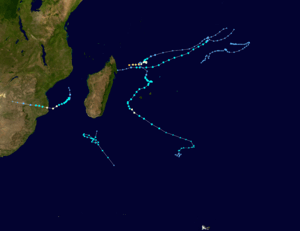2016–17 South-West Indian Ocean cyclone season
| 2016–17 South-West Indian Ocean cyclone season | |
|---|---|
|
Season summary map | |
| Seasonal boundaries | |
| First system formed | July 15, 2016 |
| Last system dissipated | March 14, 2017 |
| Strongest storm | |
| Name | Enawo |
| • Maximum winds |
205 km/h (125 mph) (10-minute sustained) |
| • Lowest pressure | 932 hPa (mbar) |
| Seasonal statistics | |
| Total disturbances | 7 official, 1 unofficial |
| Total depressions | 7 |
| Total storms | 5 |
| Tropical cyclones | 3 |
| Intense tropical cyclones | 1 |
| Total fatalities | 341 total |
| Total damage | $136.5 million (2017 USD) |
| Related articles | |
The 2016–17 South-West Indian Ocean cyclone season was a below average season with five tropical storms, with three intensifying into tropical cyclones. It officially began on November 15, 2016, and ended on April 30, 2017, with the exception for Mauritius and the Seychelles, for which it ended on May 15, 2017. These dates conventionally delimit the period of each year when most tropical and subtropical cyclones form in the basin, which is west of 90°E and south of the Equator. Tropical and subtropical cyclones in this basin were monitored by the Regional Specialised Meteorological Centre in Réunion, though the Joint Typhoon Warning Center issued unofficial advisories.
Seasonal outlook
On November 4, the Mauritius Meteorological Services (MMS) released their summer 2016–17 outlook. It is expected that six to eight cyclones will form in the Southwest Indian Ocean throughout the season from November through the first half of May. This is in addition to the two cyclones, Abela and Bransby, that formed before the outlook period. MMS also indicated that the region south of Diego Garcia would be a center of focus for cyclone formation.[1]
Seasonal summary

Despite a weak season, the first named tropical cyclone, Abela formed early on July 15. A subtropical depression formed after three months. There were no tropical cyclones in the basin in November, December or January.
Systems
Severe Tropical Storm Abela
| Severe tropical storm (MFR) | |
| Tropical storm (SSHWS) | |
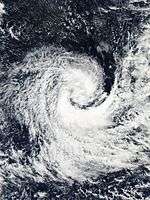  | |
| Duration | July 15 – July 20 |
|---|---|
| Peak intensity | 95 km/h (60 mph) (10-min) 987 hPa (mbar) |
On July 15, a tropical depression formed to the southwest of Diego Garcia.[2] This marked only the fourth occurrence of a tropical cyclone existing in the southwest Indian Ocean during the month of July, with the others being Moderate Tropical Storm Odette in 1971, Tropical Depression M2 in 1997 and Tropical Cyclone 01U in July 2007.[3][4] The next day, the depression acquired moderate tropical storm status as gale-force winds extended more than halfway around the center.[2] The system tracked west-southwest, organizing slowly in the face of moderate vertical wind shear. On the evening of July 17, RSMC La Réunion initiated warnings on the storm after a scatterometer pass revealed 75 km/h (45 mph) winds. At the same time, Mauritius Meteorological Services named the storm Abela.[5] The small system briefly attained severe tropical storm strength the next day as a low-level eye developed.[2][6] Abela began to weaken quickly in the subsequent hours as it moved into a region with cool sea surface temperatures and low oceanic potential.[7] Abela became a remnant low on July 20 as it neared the coast of Madagascar.[2]
Subtropical Depression Bransby
| Subtropical depression (MFR) | |
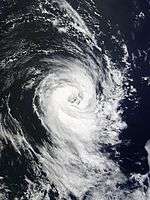  | |
| Duration | October 2 – October 6 |
|---|---|
| Peak intensity | 100 km/h (65 mph) (10-min) 987 hPa (mbar) |
A zone of disturbed weather developed into a subtropical depression to the south of Madagascar on October 2.[8] The subtropical depression was analysed in post-analysis to have developed peak winds of 95 km/h (60 mph) on October 3.[8] The system slowly weakened as it executed an anticyclonic loop until it had winds of 75 km/h (50 mph) early on October 5, when RSMC La Réunion began to operationally warn on the system and Direction Generale de la Meteorologie (DGM) of Madagascar named it Bransby.[9] Bransby went unmonitored by the Joint Typhoon Warning Center until the next day. The storm continued to weaken throughout the day until it was barely producing gale-force winds. The next day, Bransby developed a defined banding eye as it re-intensified and accelerated to the southeast.[10] Six hours later, Bransby reattained its peak intensity. RSMC La Réunion noted that Bransby had once again developed winds of 95 km/h (60 mph), equivalent to that of the severe tropical storm rating given to tropical cyclones of the same intensity.[8] Throughout the evening of October 6, the organization of Bransby deteriorated rapidly as northwesterly wind shear took its toll, resulting in rapid weakening.[11] On October 7, Bransby became a remnant low with an elongated circulation devoid of convection while moving over 16 °C waters.[12]
Tropical Depression 03
| Tropical depression (MFR) | |
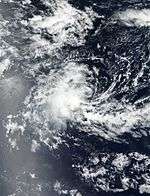  | |
| Duration | January 27 – January 28 |
|---|---|
| Peak intensity | 55 km/h (35 mph) (10-min) 1005 hPa (mbar) |
Tropical Cyclone Carlos
| Tropical cyclone (MFR) | |
| Category 1 tropical cyclone (SSHWS) | |
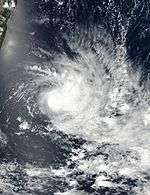 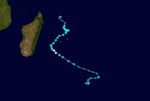 | |
| Duration | February 2 – February 10 |
|---|---|
| Peak intensity | 130 km/h (80 mph) (10-min) 965 hPa (mbar) |
Tropical Cyclone Dineo
| Tropical cyclone (MFR) | |
| Category 1 tropical cyclone (SSHWS) | |
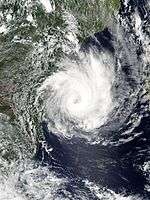  | |
| Duration | February 13 – February 17 |
|---|---|
| Peak intensity | 140 km/h (85 mph) (10-min) 955 hPa (mbar) |
Dineo struck Mozambique on February 15 as a tropical cyclone, bringing torrential rain and damaging winds.[13] Dineo was the first tropical cyclone to hit Mozambique since Cyclone Jokwe in 2008.[14] Satellite-derived estimates indicated up to 200 mm (7.9 in) of rain fell in Inhambane.[13] At least seven people were killed across the country,[15] including a child crushed by a fallen tree in Massinga.[16] An estimated 20,000 homes were destroyed and approximately 130,000 people were directly affected.[15] Widespread flooding took place in Zimbabwe, with Mutare, Chiredzi, and Beitbridge particularly hard-hit.[17] At least 251 people were killed by the storm and damage exceeded US$100 million.[18][19] The storm's remnants triggered destructive floods in Botswana.[20] In the month following the storm, a cholera outbreak in Mozambique and Malawi infected more than 1,200 people and claimed 2 lives.[21]
Intense Tropical Cyclone Enawo
| Intense tropical cyclone (MFR) | |
| Category 4 tropical cyclone (SSHWS) | |
 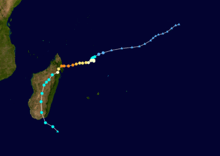 | |
| Duration | March 2 – March 9 |
|---|---|
| Peak intensity | 205 km/h (125 mph) (10-min) 932 hPa (mbar) |
On March 2, RSMC La Réunion commenced advisories on a Zone of Disturbed Weather about 250 miles (400 km) east of the Agaléga archipelago.[22]
Moderate Tropical Storm Fernando
| Moderate tropical storm (MFR) | |
| Tropical storm (SSHWS) | |
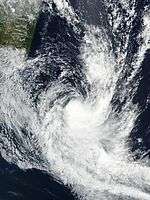 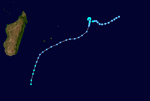 | |
| Duration | March 6 – March 14 |
|---|---|
| Peak intensity | 70 km/h (45 mph) (10-min) 992 hPa (mbar) |
Other systems
During May 30, the Australian Bureau of Meteorology started to monitor Tropical Low 31U that had developed about 2,000 km (1,245 mi) to the northwest of Jakarta, Indonesia.[23] Over the next few days the system moved south-westwards and was classified as an area of low pressure by RSMC La Reunion, before it started to fill up and dissipate on June 2.[24]
Storm names
Within the South-West Indian Ocean, tropical depressions and subtropical depressions that are judged to have 10-minute sustained windspeeds of 65 km/h (40 mph) by the Regional Specialized Meteorological Center on La Réunion Island, France (RSMC La Réunion) are usually assigned a name. However, it is the Sub-Regional Tropical Cyclone Advisory Centers in Mauritius and Madagascar who name the systems. The Sub-Regional Tropical Cyclone Advisory Center in Mauritius names a storm should it intensify into a moderate tropical storm between 55°E and 90°E. If instead a cyclone intensifies into a moderate tropical storm between 30°E and 55°E then the Sub-Regional Tropical Cyclone Advisory Center in Madagascar assigns the appropriate name to the storm. Beginning from the 2016–17 season, name lists within the South-West Indian Ocean will be rotated on a triennial basis. Storm names are only used once, so any storm name used this year will be removed from rotation and replaced with a new name for the 2019–20 season. The unused names are expected to be reused in the list for the 2019–20 season.[25]
|
|
|
Seasonal effects
This table lists all of the tropical cyclones and subtropical cyclones that were monitored during the 2016–2017 South-West Indian Ocean cyclone season. Information on their intensity, duration, name, areas affected, primarily comes from RSMC La Réunion. Death and damage reports come from either press reports or the relevant national disaster management agency while the damage totals are given in 2016 or 2017 USD.
| Name | Dates active | Peak classification | Sustained wind speeds |
Pressure | Areas affected | Damage (USD) |
Deaths | Refs |
|---|---|---|---|---|---|---|---|---|
| Abela | July 15 – 20 | Severe tropical storm | 95 km/h (60 mph) | 987 hPa (29.15 inHg) | Madagascar | None | None | |
| Bransby | October 2 – 6 | Subtropical depression | 100 km/h (65 mph) | 987 hPa (29.15 inHg) | None | None | None | |
| 03 | January 27 – 28 | Tropical depression | 55 km/h (35 mph) | 1005 hPa (29.68 inHg) | None | None | None | |
| Carlos | February 2 – 10 | Tropical cyclone | 130 km/h (80 mph) | 965 hPa (28.50 inHg) | Réunion, Mauritius | None | None | |
| Dineo | February 13 – 17 | Tropical cyclone | 140 km/h (85 mph) | 955 hPa (28.20 inHg) | Mozambique, South Africa, Zimbabwe, Botswana, Malawi | $117 million | 260 | [15][26] |
| Enawo | March 2 – 9 | Intense tropical cyclone | 205 km/h (125 mph) | 932 hPa (27.52 inHg) | Madagascar, Réunion | $20 million | 81 | [27][28][29] |
| Fernando | March 6 – 14 | Moderate tropical storm | 70 km/h (45 mph) | 992 hPa (29.29 inHg) | Rodrigues | None | None | |
| Season aggregates | ||||||||
| 7 systems | July 15 – March 14 | 205 km/h (125 mph) | 932 hPa (27.52 inHg) | $136.5 million | 341 | |||
See also
- List of Southern Hemisphere cyclone seasons
- Atlantic hurricane seasons: 2016, 2017
- Pacific hurricane seasons: 2016, 2017
- Pacific typhoon seasons: 2016, 2017
- North Indian Ocean cyclone seasons: 2016, 2017
- 2016–17 Australian region cyclone season
- 2016–17 South Pacific cyclone season
- South Atlantic tropical cyclone
References
- ↑ Rajan Mungra (November 4, 2015). "Summer 2016–2017 Outlook for the Republic of Mauritius". Mauritius Meteorological Services. Archived from the original on November 13, 2016. Retrieved November 13, 2015.
- 1 2 3 4 "ABELA : 12/07/2016 AU 20/07/2016". Météo France. Retrieved 8 October 2016.
- ↑ Soulan, Alain; Remois, Paul; Caroff, Philippe; Le Bris, Gerard (1997). 1996-1997 Tropical Cyclone Season (PDF). Meteo France. p. 69. Retrieved 16 July 2016.
- ↑ Joe Courtney (August 16, 2007). "Tropical Cyclone Report: Unnamed Tropical Cyclone" (PDF). Australian Bureau of Meteorology. Retrieved January 26, 2009.
- ↑ "TROPICAL CYCLONE FORECAST WARNING (SOUTH-WEST INDIAN OCEAN) WARNING NUMBER: 3/1/20162017 MODERATE TROPICAL STORM 1 (ABELA)" (PDF). Météo France. Retrieved 8 October 2016.
- ↑ "TROPICAL CYCLONE FORECAST WARNING (SOUTH-WEST INDIAN OCEAN) WARNING NUMBER: 7/1/20162017 MODERATE TROPICAL STORM 1 (ABELA)" (PDF). Météo France. Retrieved 8 October 2016.
- ↑ "TROPICAL CYCLONE FORECAST WARNING (SOUTH-WEST INDIAN OCEAN) WARNING NUMBER: 9/1/20162017 MODERATE TROPICAL STORM 1 (ABELA)" (PDF). Météo France. Retrieved 8 October 2016.
- 1 2 3 "BRANSBY : 02/10/2016 AU 06/10/2016". Météo France. Retrieved 7 October 2016.
- ↑ "TROPICAL CYCLONE FORECAST WARNING (SOUTH-WEST INDIAN OCEAN) WARNING NUMBER: 1/2/20162017 SUBTROPICAL DEPRESSION 2 (BRANSBY)" (PDF). Météo France. Retrieved 8 October 2016.
- ↑ "TROPICAL CYCLONE FORECAST WARNING (SOUTH-WEST INDIAN OCEAN) WARNING NUMBER: 5/2/20162017 SUBTROPICAL DEPRESSION 2 (BRANSBY)" (PDF). Météo France. Retrieved 8 October 2016.
- ↑ "TROPICAL CYCLONE FORECAST WARNING (SOUTH-WEST INDIAN OCEAN) WARNING NUMBER: 8/2/20162017 SUBTROPICAL DEPRESSION 2 (BRANSBY)" (PDF). Météo France. Retrieved 8 October 2016.
- ↑ "BULLETIN FOR CYCLONIC ACTIVITY AND SIGNIFICANT TROPICAL WEATHER IN THE SOUTHWEST INDIAN OCEAN 2016/10/07" (PDF). Météo France. Retrieved 8 October 2016.
- 1 2 Shenaaz Jamal (February 16, 2017). "Dineo lashed Mozambique with 200mm of rain". Times Live. Retrieved February 16, 2017.
- ↑ "Tropical Cyclone Dineo hits Mozambique". ReliefWeb. World Meteorological Organization. February 15, 2017. Retrieved February 16, 2017.
- 1 2 3 "Storm Dineo kills at least seven people in Mozambique - govt". Times Live. Reuters. February 16, 2017. Retrieved February 16, 2017.
- ↑ "Child 'killed by falling tree', as cyclone Dineo hits Mozambique". News 24. February 16, 2017. Retrieved February 16, 2017.
- ↑ "Cyclone Dineo Hits Zimbabwe". NewsdzeZimbabwe. February 16, 2017. Retrieved February 16, 2017.
- ↑ http://reliefweb.int/report/zimbabwe/urgent-call-assistance-flood-victims
- ↑ http://reliefweb.int/report/zimbabwe/zimbabwe-flood-snapshot-09-march-2017
- ↑ http://reliefweb.int/sites/reliefweb.int/files/resources/MDRBW003.pdf
- ↑ "Malawi Registers New Cases of Cholera". ReliefWeb. Voice of America. March 18, 2017. Retrieved March 21, 2017.
- ↑ "Tropical Cyclone Forecast Warning (South-West Indian Ocean 1/6/20162017". Tropical Cyclone Center La Réunion. Archived from the original on 2017-03-02. Retrieved 2 March 2017.
- ↑ https://www.webcitation.org/6qvWuFPJr?url=http://gwydir.demon.co.uk/advisories/IDW10800_201705300624.htm
- ↑ "WebCite query result" (PDF). www.webcitation.org. Archived from the original on 2017-06-02. Retrieved 2017-06-02.
- ↑ Regional Association I Tropical Cyclone Committee (2016). "Tropical Cyclone Operational Plan for the South-West Indian Ocean" (PDF). World Meteorological Organization. Retrieved 2016-10-05.
- ↑ "Flash Appeal: Emergency Response Plan for Mozambique - Cyclone Dineo" (PDF). ReliefWeb. UN Country Team in Mozambique. February 28, 2017. Retrieved March 1, 2017.
- ↑ "Madagascar: Cyclone Enawo Situation Report No. 3 (17 March 2017)". Relief Web. UN Office for the Coordination of Humanitarian Affairs. Retrieved 18 March 2017.
- ↑ "Madagascar cyclone death toll rises to 78". Channel NewsAsia. Agence France-Presse. March 15, 2017. Retrieved March 15, 2017.
- ↑ "Global Catastrophe Recap March 2017" (PDF). Aon Benfield. Retrieved 8 April 2017.
External links
| Wikimedia Commons has media related to 2016-17 South-West Indian Ocean cyclone season. |
